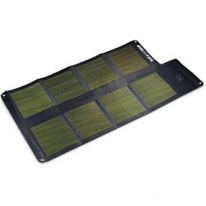What's with the Portable Solar Panel?
A couple years back at the Fly Fishing Retailer Show, an unusual booth caught my eye. Rather than being packed full of fishing equipment, the Brunton area looked more like a techie Coleman camping outlet–or maybe a place for Dr. Evil to go shopping for gadgets. Brunton makes lots of great camping stuff, but the most interesting is its lineup of solar panel equipment.

Portable solar panels are an idea whose time has aaaaalllmooosttt, but not quite, come. The only real objection these days is cost. Functionality is already incredible. Take the Brunton Solaris 26, a foldable six-panel solar array. It costs over $600; not cheap. But, in my tests, it recharged a Nikon EN-EL3e camera battery in under half an hour in full sunlight; a Motorola cell phone, an iPod, and a four-pack of AAs (for a flash) similarly took under an hour. There’s something really freaky about plugging a gadget into…nothing. You can walk around it. Pick it up; it’s not attached. And yet the little power light comes on and you’re charging. Amazing.
Of course, there’s the old objection with solar: it goes away half the time (and on cloudy days, too). Brunton addresses this with a lineup of battery packs like the Solo 7.5, which can run a laptop for around 2.5 hours and charges while you’re out hiking or fishing. 
Simply plug the Solo 7.5 into the Solaris 26, or one of the other Brunton panels, and when you come back you’re good to watch a movie or upload the day’s photos to the laptop, even in the backcountry of Yellowstone or off the grid in Brazil.
It will be a while until this technology trickles into the everyday price range for most anglers, but considering that solar panels used to weigh as much as a truck and cost thousands of dollars, Brunton has really forged ahead. For dedicated back-country anglers and world travelers, this is already a great buy.
Have a comment on how you’d use solar panels–or what you’d buy with the money instead? Share it in the Comments section!
How to Choose a Fly Fishing Travel Bag
Pros and Cons of BOA Laces











